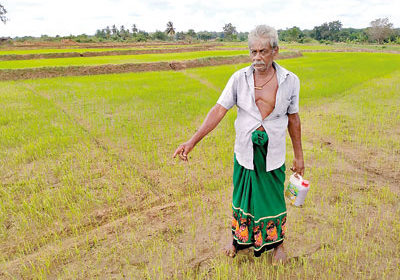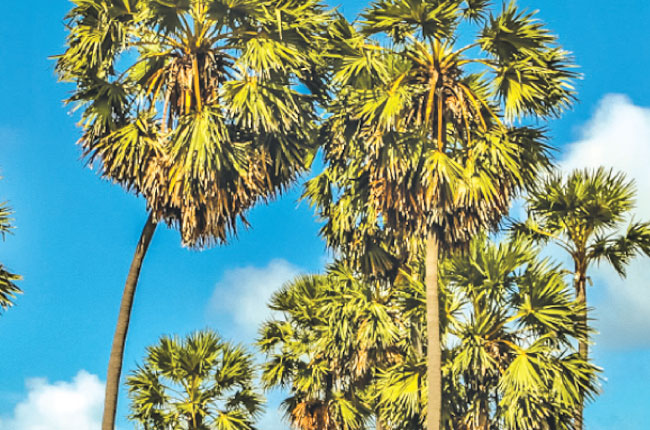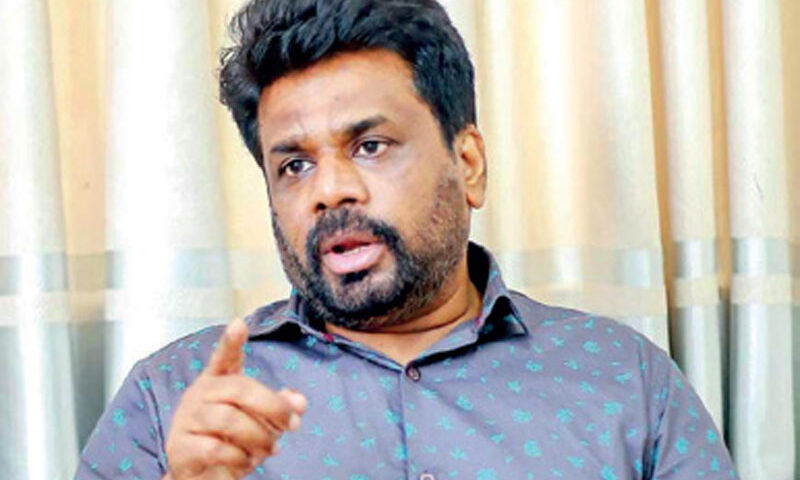 Reserves of rice will run out by September and farmers are still waiting in particular for urea distribution from the government, while private imports are being sold at exorbitant prices.
Reserves of rice will run out by September and farmers are still waiting in particular for urea distribution from the government, while private imports are being sold at exorbitant prices.
Farmers who have yet to get chemical fertiliser or fuel from the government, will be cultivating fewer hectares during the Yala season.
Agriculture Minister Mahinda Amaraweera told the Sunday Times that after negotiations with India, supplies are expected, but he could not immediately confirm a date.
Karuwalagaswewa: No fertiliser, no healthy harvest. Pic by Hiran Priyankara
He is confident stocks will arrive.
On Tuesday he appealed to Sri Lankans to grow alternative crops in their home gardens ahead of a predicted food crisis.
A senior official of the Agriculture Department said the Yala growing season has begun and the delay in fertiliser distribution will have an adverse impact on paddy cultivation.
The Agriculture Department Director General Dr. Ajantha de Silva said: “Rice reserves in the country will run out by September. After that we will be in danger. After September, it will be possible to forecast the quantity of rice available in the country based on the harvest of the Yala season. We must have fertiliser to ensure the success of this harvest. It is not enough to bring in fertiliser, the price will have to stabilise for a certain period, too.”
The annual production of paddy in Sri Lanka is about four 400,000 metric tons, from which 3.2 MT of rice can be obtained. The annual consumption is 200,000 MT. Accordingly, annually, a surplus of rice which will be adequate for another six months is created.
Rice from the Maha season will be in stock until September of the next year. However, since the harvest of the Maha season in 2021 dropped by about 40%, certain paddy farmers are not keen to start cultivation during the Yala season without chemical fertilisers, Dr de Silva pointed out.
The government had to import rice because the Maha season of 2021 was a failure, as a result of the chemical fertiliser ban by President Gotabaya Rajapaksa and the overnight switch to organic farming.
If chemical fertiliser is not received before June 15, it would be of no use, the National Fertiliser Secretariat, the regulator, said.
Director general, Chandana Lokuhewagama said recommendations about imported chemical fertiliser has not been received from the Department of Agriculture so far.
“Usually when importing fertiliser, recommendations are submitted to us by the DG of the Department of Agriculture. Then, the Colombo Commercial Fertiliser Company & Ceylon Fertiliser Company under the government, request us to import. However, none of these things has happened. We understand that the reason for this is that there is a delay in importing fertiliser from India,” he said.
So far, private companies have imported 21,000 metric tons of urea, 46,000 MT of ammonium sulphate and 21,000 MT of (MOP – KSL) potassium chloride.
A sack of 50 kilograms of urea is being sold by private businessmen for Rs. 37,000, farmers allege.
In Sri Lanka, 247,000 MT of chemical fertiliser, is needed for paddy cultivation in Yala and Maha seasons. About 40% of this is needed for Yala and 70% for Maha.
Official statistics of the NFS indicate that this costs Rs. 35 billion annually. About 50,000 hectares are cultivated at Yala, but now only about 325,000 hectares are being cultivated using organic fertiliser.
The Agriculture Department’s Dr de Silva said farmers delayed cultivation due to many uncertainties, including the lack of chemical fertiliser and the fuel crisis.



